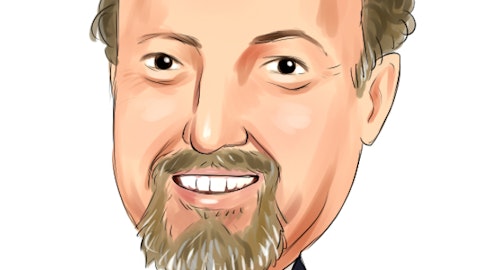Mike Mayo: Hi. You’re guiding to $90 billion of expenses. That’s up $7 billion year-over-year. Seems like quite a big increase. And if you could just give some color on that. I know we’ve been through this before, two years ago with the big increase in expenses and without a lot of visibility. So if you could just upfront give us visibility. How much of that is due to incentive pay? How much is that due to tech? How much is that due to AI? And what are the expected returns to get from that $7 billion pickup? Thanks.
Jeremy Barnum: Yes, Mike, thanks for the question. And – yes, and of course, you will, as I noted, be hearing more from us at Investor Day and between now and Investor Day. But I will take a little bit of extra time here to answer your question, because you’re right, it’s important to give you the transparency. And I’m going to follow the structure that we used on the page and go through each line of business. So starting with CCB, it’s the biggest dollar driver overall. It’s an 8% increase year-on-year, which is about the same as we had last year. One key driver is the branch strategy and the associated staff for that. In 2023, we built 166 new branches and we’re planning about a similar number this year. Marketing is also a driver.
We’re seeing great opportunities, great demand and engagement in our card products and so that shows up in marketing. And as you well know, our wealth strategy and CCB remains a big focus and priority. I think it’s worth noting here, right, that as we’ve talked about and as you know Mike, some of our investments are designed to produce short-term payoffs and some of them are much longer-term and some of them are just table stakes. But we actually see quite a bit of evidence of current payoffs in our current results in the CCB investment. So for example, in 2023, we had 2 million net new checking accounts, we had an 8% growth in active card accounts, and over the last three years, we’ve increased deposit market share by 180 basis points. So as we’ve often said about the company as a whole, we’re very happy to be producing very good current returns and growth while investing for the future.
In AWM, continued client advisor hiring is a key driver, as well as making sure that both the advisors and all of their new clients have the support that they need. And a little bit to the prior question, in AWM we also have a little bit of volume and revenue-related driver tied to an improved revenue outlook. The Commercial Bank is an interesting story in the sense that about half of it is the exit rate impact of ads that we did in the middle of the year based on market disruption and all the kind of new clients and new loans that we saw and the need to support that across the entire ecosystem, as well as the fact that that created an opportunity in the middle of the year to accelerate our long-standing and pre-existing innovation economy strategy.
So we took some opportunities to onboard some key teams in different parts of the franchise. And then as you look into 2024, it’s really pretty consistent themes for the ones that we had before, including hiring bankers both domestically and internationally. The CIB story is a little bit different. The percentage growth there is lower, which recognizes, I think, both our very, very strong share positions as a starting point and also the fact that we’ve been investing quite aggressively for some time in the payments business, which has produced meaningful payoffs already there in terms of significant share gains. So as a result, the biggest driver in the CIB is really generic inflation, including labor, as well as, again, to the prior question, volume and revenue-related increases tied to the improved NIR outlook.
And I do want to say for the avoidance of doubt, that despite all of this, our core strategy of looking very granularly at all the areas of strength and weakness and making sure that we’re upgrading where appropriate to have absolutely the best talent in the CIB remains fully in effect. Finally, you’ll note that I haven’t actually talked about technology in any of the businesses. And that’s actually because even though all of the businesses in various ways are investing in technology and spending money on it, the drivers are actually very consistent across the entire firm, even though it’s very bottoms-up driven. And those drivers are consistent with what they’ve been, new products, features, and customer platforms, as well as modernization.
So that’s happening throughout the company, both at the app level and otherwise. And I will say, actually, in closing, talking about technology, which I think is interesting, that to the point about a driver being growth writ large, one of the things that we see is higher volume-related technology expense throughout the company. So thanks for the question, Mike. It was a good opportunity to give you guys a bit more color here.
Mike Mayo: Okay. I have a short follow-up. I’m still here.
Jeremy Barnum: Sure.
Mike Mayo: Yes. Can you just talk about the impact of AI on your technology approach? And I know I asked you this before, and you said you’re spending it, you’re being careful, you want to see a return on your dollars. But how much difference can this make? How big is your tech budget last year? How much should it be this year? How much should AI make a difference? Just a little bit more meat on the tech bones.
Jeremy Barnum: Yes, sure. So let me address the AI point, and I think maybe I won’t go into a lot of quantitative detail on this stuff, and I’ll save that for Investor Day, if you don’t mind. But I will address the AI point. So, as you may be aware, we actually have Teresa Heitsenrether now running the AI strategy for the company as a member of the Operating Committee, which I think is an indication of the priority that we place on this and in partnership with Lori and all of the technology organization. So I think that – I think of this as being a little bit barbelled, where on the one hand, we’re very excited about this. There’s clearly some very significant opportunities, not for nothing, starting with technology developers themselves, in terms of the opportunity for significantly increased productivity there.
At the same time, we’re JPMorgan Chase. We’re not going to be chasing shiny objects here in AI. We want to do this in an extremely disciplined way. It’s very commercial and very linked to tangible outcomes. And so the current focus is on making sure we have a contained, well-chosen list of high-impact use cases and that we’re throwing resources at those in the right way that’s extremely pragmatic and disciplined, and we’re holding ourselves accountable for actual results.
Mike Mayo: All right. Thank you.
Jeremy Barnum: Thanks, Mike.
Operator: Next, we’ll go to the line of Gerard Cassidy from RBC Capital Markets. You may proceed.
Gerard Cassidy: Hi, Jeremy. How are you?
Jeremy Barnum: Hi, Gerard.





